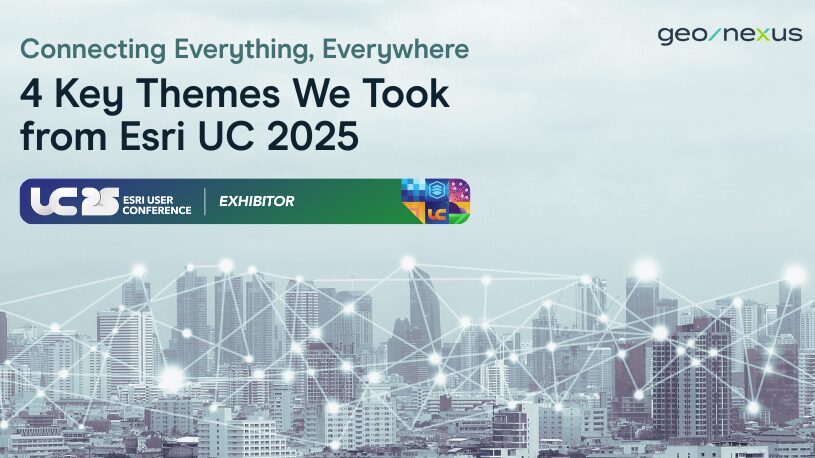
Esri’s User Conference isn’t just where the GIS community gathers, it’s where the direction of the industry becomes tangible. This year’s theme, “Integrating Everything, Everywhere,” couldn’t be more aligned with where the market is going and with how Geonexus is supporting asset intensive organizations across the globe.
As always, our booth gave us a front-row seat to what customers, prospects, and partners are wrestling with. And in dozens of conversations — from quick demos to deep strategy chats — four themes emerge loud and clear.
Support for the Esri Utility Network must go deeper and smarter.
One of the clearest patterns this year: customers are no longer asking if they’ll move to the Esri Utility Network — they’re asking how their systems will keep up once they do. That includes far more than just spatial asset records.
“Customers want confidence that their integration solution can synchronize with the Esri Utility Network, not just at the asset level, but also with advanced network functionality.”
— Umesh Menon, VP, Strategic Product Management (Geonexus)
This means supporting branch versioning. It means reading and creating network associations. It means handling object-oriented data models that don’t behave like simple records anymore. And it means doing all of that while keeping systems like Maximo or SAP perfectly in sync, in real time. GIP is already built to understand the Utility Network’s complexity.
Partners and customers alike are choosing how and who they integrate with.
This year’s UC made one thing clear: most organizations aren’t starting from scratch. They’re navigating existing integrations — some homegrown, some vendor-built, some deeply embedded — and trying to decide what’s worth keeping.
“We kept hearing questions like: Are we replacing every integration as part of this project? Are we adding a platform like GIP to simplify what we already have? Or are we merging systems while keeping a few direct integrations in place?”
— Josh Swenson, VP, Revenue Operations (Geonexus)
These are architecture-level decisions. And more often than not, customers are deciding they need a smarter foundation: a platform that simplifies complexity, supports coexistence, and gives them future flexibility.
GIP supports that thinking. We help customers phase out legacy scripts, preserve what works, and standardize what comes next. It’s not about ripping and replacing. It’s about integrating with intention.
We’re not replacing Esri. Or Maximo. Or SAP. We’re making sure they all work together — seamlessly.
With major upgrades happening across platforms like SAP, Esri, and Maximo, utility technology leaders are asking bigger questions — not just about the capabilities of each system, but how they all fit together. The focus is shifting from siloed software to unified workflows.
That’s where integration comes in. Not as an afterthought, but as the strategy that determines whether these powerful platforms can actually deliver value together.
At this year’s UC, many of the most insightful conversations we had centered on how Geonexus can serve as the connective tissue — a purpose-built integration layer that ensures data moves efficiently and accurately across systems, and that geospatial intelligence is preserved and leveraged throughout.
“Geonexus isn’t the star of the show — and we’re not trying to be. The real heavy lifters are platforms like Esri, SAP, and Maximo. Our role is to make sure they work together seamlessly. When your systems are connected and data is flowing reliably, your teams can finally act on the full picture. That’s how we empower the full solution.”
— Skip Heise, Founder & CEO (Geonexus)
And that’s resonating in the partner community too. Vendors who used to build one-off integrations are now exploring how Geonexus can embed into their own offerings by speeding up delivery, reducing maintenance, and improving outcomes.
This is how integration becomes a growth strategy, not just a technical checkbox.
In his opening remarks, Esri President Jack Dangermond called on the GIS community to recognize the rising complexity of our world and the increasing responsibility we have to understand it. He described GIS as a “nervous system for the planet,” and emphasized the need to integrate not just data, but disciplines, institutions, and workflows.
That call to action was echoed throughout the week. In session after session, we saw examples of organizations using GIS as the common operating picture across planning, operations, and emergency response.
From digital twins to real-time analytics, the best examples weren’t just map-driven — they were system-driven. Whether it was emergency response in New York or airport ops in San Francisco, the message was clear: GIS thrives when it’s integrated. The industry isn’t just imagining the future anymore — it’s implementing it. And platforms like GIP are what make that leap possible.
Esri’s vision of “Integrating Everything, Everywhere” wasn’t just a theme. It’s the reality our customers are navigating right now as they modernize platforms, embrace cloud-first strategies, and prepare for AI-driven operations.
If you’re asking:
We’re already helping organizations solve those problems. Let’s build what’s next — together.
For more on how Geonexus is helping customer solve their integration challenges, watch this latest webinar: GIS Integration Unlocked: Real-World Solutions from Industry Leaders.
Contact us to book a demo!